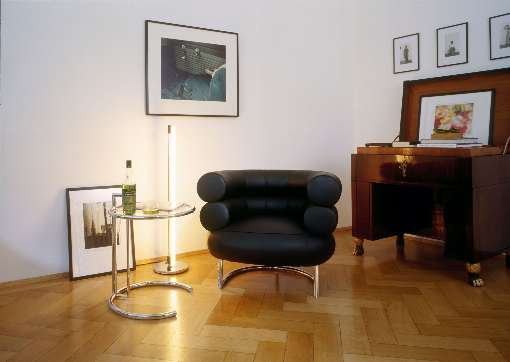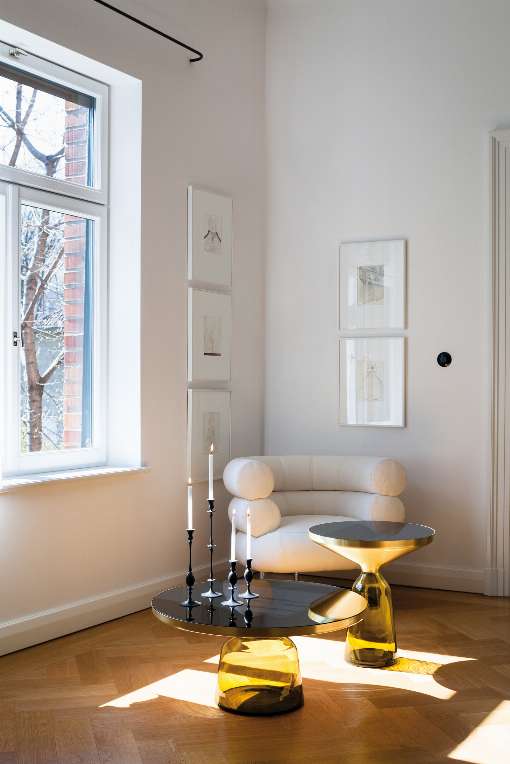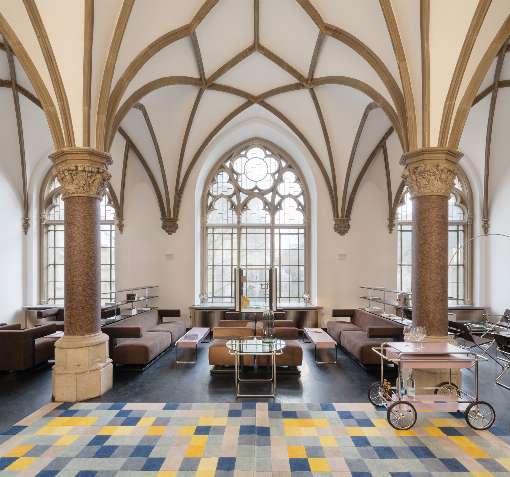12.08.2024
105 years of Bauhaus and the “fillet of the tree”:
Bonn. Something new comes into the world by making something old new. This was the basic idea behind the Bauhaus. Founded by architect Walter Gropius in Weimar in 1919 and banned by the Nazis in 1933, the brief period of the state Bauhaus has had a major influence on the architecture of houses and the design of furniture and furnishings to this day. Today we know that the inventors of the Bauhaus movement were first concerned with the process of development and then with the end result of the design. For this reason, the various disciplines were always combined on an equal footing, from the initial idea through to implementation and production. Architects developed floor plans together with carpenters and painters, just as artists worked with jewelry designers and textile specialists to design furniture. This approach to designing houses, apartments, furniture and furnishings was unique and is Bauhaus.
There was no uniform Bauhaus style. All the design ideas were motivated by an inner rebellion against the conventional and the traditional, the old. It was about opposition: from the design process to the product. What the typical Bauhaus design has in common above all is the leap into modernity. And not without reason: the previous years had been characterized in furniture design by stuffy bourgeoisie, by Biedermeier and, shortly before that, by romantic and playful Art Nouveau. The architecture of the time was also petty bourgeois and narrow and did not make use of any tangible or traditional stylistic elements. From the point of view of the young Bauhaus movement, none of this fitted in well with the increasingly modern times.
Around 100 years ago, Europe and Germany were experiencing a spirit of optimism in all social circles and major shifts in areas that were becoming economically more successful. Industrial products such as automobiles and the mass production of furniture became more important. Machines and assembly lines shaped production processes. Ultimately, the entire value creation process, which had previously been carried out by craftsmen, became industrialized. The Bauhaus movement developed the design response of simple functionality and saw this as a real opportunity for affordable construction and furniture costs for all sections of the population.
Architecture and design were geometrically simplified. Playfulness was rejected and the superfluous reduced. The new elegance lay in simple form. The Bauhaus recipe therefore resulted in predominantly sober designs that must have had a revolutionary effect at the time and are still considered “classics” today. However, Bauhaus was an attitude to life of freedom and more than a specific style. However, some stylistic elements are still identified with Bauhaus today. The so-called Bauhaus style is therefore particularly popular today in contemporary architecture, and somewhat less so in furniture design. Here, the post-war coziness of the 1960s - with coffee tables and monstera - has been conquering living rooms for some years now. Original Bauhaus furniture is still considered iconic and continues to be attractive to a small but steadily growing target group.
Furniture classics by designers such as Le Corbusier, Gerrit Rietveld, Eileen Gray, Mart Stam or the architects Walter Gropius, Ludwig Mies van der Rohe and Marcel Breuer are still in production today. They are considered timeless and are always in, although they have never really been out. It is striking that these icons are often used as the basis for new designs in all furniture-producing countries or are even reproduced in a very similar way. No other known style has been imitated to such an extent and continuously for over 100 years.
Wood was and is particularly influential in terms of style, especially in the Bauhaus era, even if it was more of a mass product for a long time. The natural material has always made a name for itself as the basis for timeless design objects - be it small objects, furniture or entire buildings. Its veneer was particularly popular in the furniture workshops of the Bauhaus. For example, as a surface for plywood seat shells, for the surfaces of blockboard, for table tops and shelves or for room doors. However, it was one of the traditional materials that was available in large quantities at a time when resource consumption was not yet an issue. “Its contemporary understanding, as a thin, individual and economical raw material, had not yet been developed. Today's possibilities of producing, finishing, varnishing, printing and combining the 'fillet of the tree' with other natural materials such as wool had not yet been invented,” says Ursula Geismann, Managing Director of the Initiative Veneer + Nature (IFN) and trend analyst in design matters. Today, the material is experiencing a renaissance. “Ideas from back then are being taken up again and classics are being revived. But there are also designers who are taking a completely different path: the trend away from the traditional, if you think of bank cards, sunglasses or drinking cups that are replacing plastic. Or the ever-increasing desire to preserve the beautiful and natural properties of solid wood in a thin and stable form that conserves resources and thus protects the climate,” explains Geismann, adding: ”The architects, interior designers and carpenters of the Bauhaus would be delighted with veneer today more than ever. It is unconventional and really something new.” IFN/UG
Initiative Veneer + Nature (IFN)
The Initiative Furnier + Natur (IFN) e.V. was founded in 1996 by the German veneer industry and its partners. Today it is supported by European companies from the veneer industry, the trade and the veneer processing industry as well as trade associations of the wood industry. The aim of the association is to promote veneer as a natural all-round material.
Further information about the IFN at:
furnier.de/en
wood-veneer-stories.de
facebook
linkedin
instagram
Image 1: The furniture from the Bauhaus era that has been reissued today fits into any ambience. Walter Gropius sofas and Marcel Breuer's shelving system with American walnut veneer, combined with the new console trolley produced in the Bauhaus style, make the furnishings appear valuable but not overwhelming. Photo: Tecta. www.tecta.de/en/
Image 2: Bauhaus classics have remained the same to this day, even if they have been further developed in black - as here according to a design by Eileen Gray. Photo: ClassiCon authorized by The World Licence Holder Aram Designs Ltd, photographer: Daniel Breidt. www.classicon.com
Image 3: Still a favorite Bauhaus classic today: the “Bibendum Armchair” by Eileen Gray from 1929 with its typical round beads in white leather. Photo: ClassiCon authorized by The World Licence Holder Aram Designs Ltd, www.classicon.com
August 12, 2024
Initiative Furnier + Natur e.V. - Bonner Talweg 84 - D-53113 Bonn - m +49 171 1783 444 www.furnier.de - www.veneer.eu - presse@furnier.de
105 years of Bauhaus and the “fillet of the tree”:
A tribute to aesthetic diversity
Bonn. Something new comes into the world by making something old new. This was the basic idea behind the Bauhaus. Founded by architect Walter Gropius in Weimar in 1919 and banned by the Nazis in 1933, the brief period of the state Bauhaus has had a major influence on the architecture of houses and the design of furniture and furnishings to this day. Today we know that the inventors of the Bauhaus movement were first concerned with the process of development and then with the end result of the design. For this reason, the various disciplines were always combined on an equal footing, from the initial idea through to implementation and production. Architects developed floor plans together with carpenters and painters, just as artists worked with jewelry designers and textile specialists to design furniture. This approach to designing houses, apartments, furniture and furnishings was unique and is Bauhaus.
There was no uniform Bauhaus style. All the design ideas were motivated by an inner rebellion against the conventional and the traditional, the old. It was about opposition: from the design process to the product. What the typical Bauhaus design has in common above all is the leap into modernity. And not without reason: the previous years had been characterized in furniture design by stuffy bourgeoisie, by Biedermeier and, shortly before that, by romantic and playful Art Nouveau. The architecture of the time was also petty bourgeois and narrow and did not make use of any tangible or traditional stylistic elements. From the point of view of the young Bauhaus movement, none of this fitted in well with the increasingly modern times.
Around 100 years ago, Europe and Germany were experiencing a spirit of optimism in all social circles and major shifts in areas that were becoming economically more successful. Industrial products such as automobiles and the mass production of furniture became more important. Machines and assembly lines shaped production processes. Ultimately, the entire value creation process, which had previously been carried out by craftsmen, became industrialized. The Bauhaus movement developed the design response of simple functionality and saw this as a real opportunity for affordable construction and furniture costs for all sections of the population.
Architecture and design were geometrically simplified. Playfulness was rejected and the superfluous reduced. The new elegance lay in simple form. The Bauhaus recipe therefore resulted in predominantly sober designs that must have had a revolutionary effect at the time and are still considered “classics” today. However, Bauhaus was an attitude to life of freedom and more than a specific style. However, some stylistic elements are still identified with Bauhaus today. The so-called Bauhaus style is therefore particularly popular today in contemporary architecture, and somewhat less so in furniture design. Here, the post-war coziness of the 1960s - with coffee tables and monstera - has been conquering living rooms for some years now. Original Bauhaus furniture is still considered iconic and continues to be attractive to a small but steadily growing target group.
Furniture classics by designers such as Le Corbusier, Gerrit Rietveld, Eileen Gray, Mart Stam or the architects Walter Gropius, Ludwig Mies van der Rohe and Marcel Breuer are still in production today. They are considered timeless and are always in, although they have never really been out. It is striking that these icons are often used as the basis for new designs in all furniture-producing countries or are even reproduced in a very similar way. No other known style has been imitated to such an extent and continuously for over 100 years.
Wood was and is particularly influential in terms of style, especially in the Bauhaus era, even if it was more of a mass product for a long time. The natural material has always made a name for itself as the basis for timeless design objects - be it small objects, furniture or entire buildings. Its veneer was particularly popular in the furniture workshops of the Bauhaus. For example, as a surface for plywood seat shells, for the surfaces of blockboard, for table tops and shelves or for room doors. However, it was one of the traditional materials that was available in large quantities at a time when resource consumption was not yet an issue. “Its contemporary understanding, as a thin, individual and economical raw material, had not yet been developed. Today's possibilities of producing, finishing, varnishing, printing and combining the 'fillet of the tree' with other natural materials such as wool had not yet been invented,” says Ursula Geismann, Managing Director of the Initiative Veneer + Nature (IFN) and trend analyst in design matters. Today, the material is experiencing a renaissance. “Ideas from back then are being taken up again and classics are being revived. But there are also designers who are taking a completely different path: the trend away from the traditional, if you think of bank cards, sunglasses or drinking cups that are replacing plastic. Or the ever-increasing desire to preserve the beautiful and natural properties of solid wood in a thin and stable form that conserves resources and thus protects the climate,” explains Geismann, adding: ”The architects, interior designers and carpenters of the Bauhaus would be delighted with veneer today more than ever. It is unconventional and really something new.” IFN/UG
Initiative Veneer + Nature (IFN)
The Initiative Furnier + Natur (IFN) e.V. was founded in 1996 by the German veneer industry and its partners. Today it is supported by European companies from the veneer industry, the trade and the veneer processing industry as well as trade associations of the wood industry. The aim of the association is to promote veneer as a natural all-round material.
Further information about the IFN at:
furnier.de/en
wood-veneer-stories.de
Image 1: The furniture from the Bauhaus era that has been reissued today fits into any ambience. Walter Gropius sofas and Marcel Breuer's shelving system with American walnut veneer, combined with the new console trolley produced in the Bauhaus style, make the furnishings appear valuable but not overwhelming. Photo: Tecta. www.tecta.de/en/
Image 2: Bauhaus classics have remained the same to this day, even if they have been further developed in black - as here according to a design by Eileen Gray. Photo: ClassiCon authorized by The World Licence Holder Aram Designs Ltd, photographer: Daniel Breidt. www.classicon.com
Image 3: Still a favorite Bauhaus classic today: the “Bibendum Armchair” by Eileen Gray from 1929 with its typical round beads in white leather. Photo: ClassiCon authorized by The World Licence Holder Aram Designs Ltd, www.classicon.com
August 12, 2024
Initiative Furnier + Natur e.V. - Bonner Talweg 84 - D-53113 Bonn - m +49 171 1783 444 www.furnier.de - www.veneer.eu - presse@furnier.de

Image 1: The furniture from the Bauhaus era that has been reissued today fits into any ambience. Walter Gropius sofas and Marcel Breuer's shelving system with American walnut veneer, combined with the new console trolley produced in the Bauhaus style, make the furnishings appear valuable but not overwhelming. Photo: Tecta. www.tecta.de

Image 2: Bauhaus classics have remained the same to this day, even if they have been further developed in black - as here according to a design by Eileen Gray. Photo: ClassiCon authorized by The World Licence Holder Aram Designs Ltd, photographer: Daniel Breidt. www.classicon.com

Image 3: Still a favorite Bauhaus classic today: the “Bibendum Armchair” by Eileen Gray from 1929 with its typical round beads in white leather. Photo: ClassiCon authorized by The World Licence Holder Aram Designs Ltd, www.classicon.com